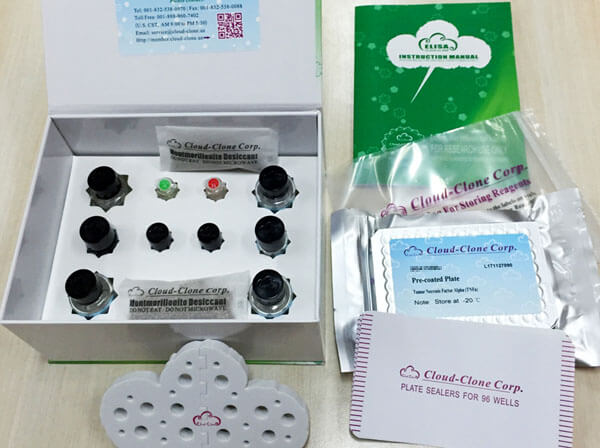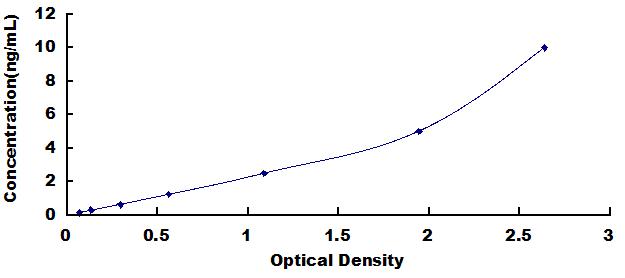ELISA Kit for Tyrosine Hydroxylase (TH) 

TYH; DYT5b; Tyrosine 3-Monooxygenase; Dystonia 14
- UOM
- FOB US$ 479.00 US$ 684.00 US$ 3,078.00 US$ 5,814.00 US$ 47,880.00
- Quantity
Overview
Properties
- Product No.SEB438Mi
- Organism SpeciesHomo sapiens (Human), Mus musculus (Mouse), Rattus norvegicus (Rat) Same name, Different species.
- ApplicationsEnzyme-linked immunosorbent assay for Antigen Detection.
Research use only - DownloadInstruction Manual
- CategorySignal transductionEnzyme & KinaseNeuro scienceHormone metabolism
Sign into your account
Share a new citation as an author
Upload your experimental result
Review

Contact us
Please fill in the blank.
Recovery
Matrices listed below were spiked with certain level of recombinant Tyrosine Hydroxylase (TH) and the recovery rates were calculated by comparing the measured value to the expected amount of Tyrosine Hydroxylase (TH) in samples.
| Matrix | Recovery range (%) | Average(%) |
| serum(n=5) | 81-91 | 85 |
| EDTA plasma(n=5) | 78-103 | 90 |
| heparin plasma(n=5) | 87-101 | 91 |
Precision
Intra-assay Precision (Precision within an assay): 3 samples with low, middle and high level Tyrosine Hydroxylase (TH) were tested 20 times on one plate, respectively.
Inter-assay Precision (Precision between assays): 3 samples with low, middle and high level Tyrosine Hydroxylase (TH) were tested on 3 different plates, 8 replicates in each plate.
CV(%) = SD/meanX100
Intra-Assay: CV<10%
Inter-Assay: CV<12%
Linearity
The linearity of the kit was assayed by testing samples spiked with appropriate concentration of Tyrosine Hydroxylase (TH) and their serial dilutions. The results were demonstrated by the percentage of calculated concentration to the expected.
| Sample | 1:2 | 1:4 | 1:8 | 1:16 |
| serum(n=5) | 95-103% | 94-102% | 80-97% | 82-93% |
| EDTA plasma(n=5) | 86-101% | 89-101% | 86-94% | 95-103% |
| heparin plasma(n=5) | 95-103% | 90-98% | 81-102% | 85-101% |
Stability
The stability of kit is determined by the loss rate of activity. The loss rate of this kit is less than 5% within the expiration date under appropriate storage condition.
To minimize extra influence on the performance, operation procedures and lab conditions, especially room temperature, air humidity, incubator temperature should be strictly controlled. It is also strongly suggested that the whole assay is performed by the same operator from the beginning to the end.
Reagents and materials provided
| Reagents | Quantity | Reagents | Quantity |
| Pre-coated, ready to use 96-well strip plate | 1 | Plate sealer for 96 wells | 4 |
| Standard | 2 | Standard Diluent | 1×20mL |
| Detection Reagent A | 1×120µL | Assay Diluent A | 1×12mL |
| Detection Reagent B | 1×120µL | Assay Diluent B | 1×12mL |
| TMB Substrate | 1×9mL | Stop Solution | 1×6mL |
| Wash Buffer (30 × concentrate) | 1×20mL | Instruction manual | 1 |
Assay procedure summary
1. Prepare all reagents, samples and standards;
2. Add 100µL standard or sample to each well. Incubate 1 hours at 37°C;
3. Aspirate and add 100µL prepared Detection Reagent A. Incubate 1 hour at 37°C;
4. Aspirate and wash 3 times;
5. Add 100µL prepared Detection Reagent B. Incubate 30 minutes at 37°C;
6. Aspirate and wash 5 times;
7. Add 90µL Substrate Solution. Incubate 10-20 minutes at 37°C;
8. Add 50µL Stop Solution. Read at 450nm immediately.

Test principle
The test principle applied in this kit is Sandwich enzyme immunoassay. The microtiter plate provided in this kit has been pre-coated with an antibody specific to Tyrosine Hydroxylase (TH). Standards or samples are then added to the appropriate microtiter plate wells with a biotin-conjugated antibody specific to Tyrosine Hydroxylase (TH). Next, Avidin conjugated to Horseradish Peroxidase (HRP) is added to each microplate well and incubated. After TMB substrate solution is added, only those wells that contain Tyrosine Hydroxylase (TH), biotin-conjugated antibody and enzyme-conjugated Avidin will exhibit a change in color. The enzyme-substrate reaction is terminated by the addition of sulphuric acid solution and the color change is measured spectrophotometrically at a wavelength of 450nm ± 10nm. The concentration of Tyrosine Hydroxylase (TH) in the samples is then determined by comparing the O.D. of the samples to the standard curve.
Giveaways
Increment services
-
 Single-component Reagents of Assay Kit
Single-component Reagents of Assay Kit
-
 Lysis Buffer Specific for ELISA / CLIA
Lysis Buffer Specific for ELISA / CLIA
-
 Quality Control of Kit
Quality Control of Kit
-
 ELISA Kit Customized Service
ELISA Kit Customized Service
-
 Disease Model Customized Service
Disease Model Customized Service
-
 Serums Customized Service
Serums Customized Service
-
 TGFB1 Activation Reagent
TGFB1 Activation Reagent
-
 Real Time PCR Experimental Service
Real Time PCR Experimental Service
-
 Streptavidin
Streptavidin
-
 Fast blue Protein Stain solution
Fast blue Protein Stain solution
-
 Single-component Reagents of FLIA Kit
Single-component Reagents of FLIA Kit
-
 Streptavidin-Agarose Beads
Streptavidin-Agarose Beads
Citations
- 1, 25-dyhydroxyvitamin D3 Attenuates l-DOPA-Induced Neurotoxicity in Neural Stem CellsPubmed:25102940
- Genetic Diagnosis of Two Dopa-Responsive Dystonia Families by Exome SequencingPubmed:25181484
- Acetyl-l-carnitine protects dopaminergic nigrostriatal pathway in 6-hydroxydopamine-induced model of Parkinson's disease in the rat.pubmed:28199883
- Elevated blood plasma levels of epinephrine, norepinephrine, tyrosine hydroxylase, TGFβ1, and TNFα associated with high-altitude pulmonary edema in an Indian population.pubmed:27540296
- Silencing salusin-β attenuates cardiovascular remodeling and hypertension in spontaneously hypertensive rats.pubmed:28230187
- Vaccarin administration ameliorates hypertension and cardiovascular remodeling in renovascular hypertensive ratspubmed:28681939
- Multigenerational disruption of the thyroid endocrine system in marine medaka after a life-cycle exposure to perfluorobutanesulfonatePubmed:29565584
- Cilostazol Mediated Nurr1 and Autophagy Enhancement: Neuroprotective Activity in Rat Rotenone PD ModelPubmed:29429051
- Tetrabromobisphenol A caused neurodevelopmental toxicity via disrupting thyroid hormones in zebrafish larvaePubmed:29407805
- The Effect of Recombinant Tyrosine Hydroxylase Expression on the Neurogenic Differentiation Potency of Mesenchymal Stem CellsPubmed:29656620
- Montelukast attenuates rotenone-induced microglial activation/p38 MAPK expression in rats: Possible role of its antioxidant, anti-inflammatory and antiapoptotic effectsPubmed: 30222980
- Silencing salusin β ameliorates heart failure in aged spontaneously hypertensive rats by ROS-relative MAPK/NF-κB pathways in the paraventricular nucleusPubmed: 30581101
- Hydroxychloroquine antiparkinsonian potential: Nurr1 modulation versus autophagy inhibition
- Perfluoropolyether carboxylic acids (novel alternatives to PFOA) impair zebrafish posterior swim bladder development via thyroid hormone disruptionPubmed: 31733528
- Embryonic exposure to pentabromobenzene inhibited the inflation of posterior swim bladder in zebrafish larvaePubmed: 31935612
- Nose to brain delivery of rotigotine loaded chitosan nanoparticles in human SH-SY5Y neuroblastoma cells and animal model of Parkinson's diseasePubmed: 32084576
- Thyroid disruption and developmental toxicity caused by Cd2+ in Schizopygopsis younghusbandi larvaePubmed: 32344129
- Selection of Cells for Parkinson's Disease Cell-Therapy
- Effects of SiO2 nanoparticles on the uptake of tetrabromobisphenol A and its impact on the thyroid endocrine system in zebrafish larvae33385677
- Tocotrienols protect differentiated SH-SY5Y human neuroblastoma cells against 6-hydroxydopamine-induced cytotoxicity by ameliorating dopamine biosynthesis and …Pubmed:35065349
- Omarigliptin attenuates rotenone-induced Parkinson's disease in rats: Possible role of oxidative stress, endoplasmic reticulum stress and immune modulationPubmed:35439590
- Unravelling the neuroprotective mechanisms of carotenes in differentiated human neural cells: biochemical and proteomic approachesPubmed:35415676
- Parental and transgenerational impairments of thyroid endocrine system in zebrafish by 2, 4, 6-tribromophenol








